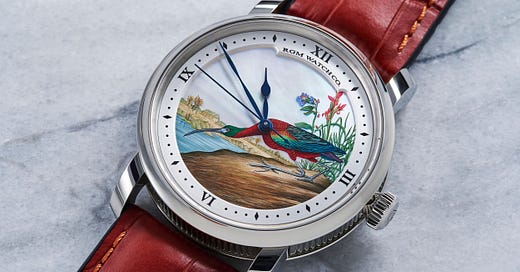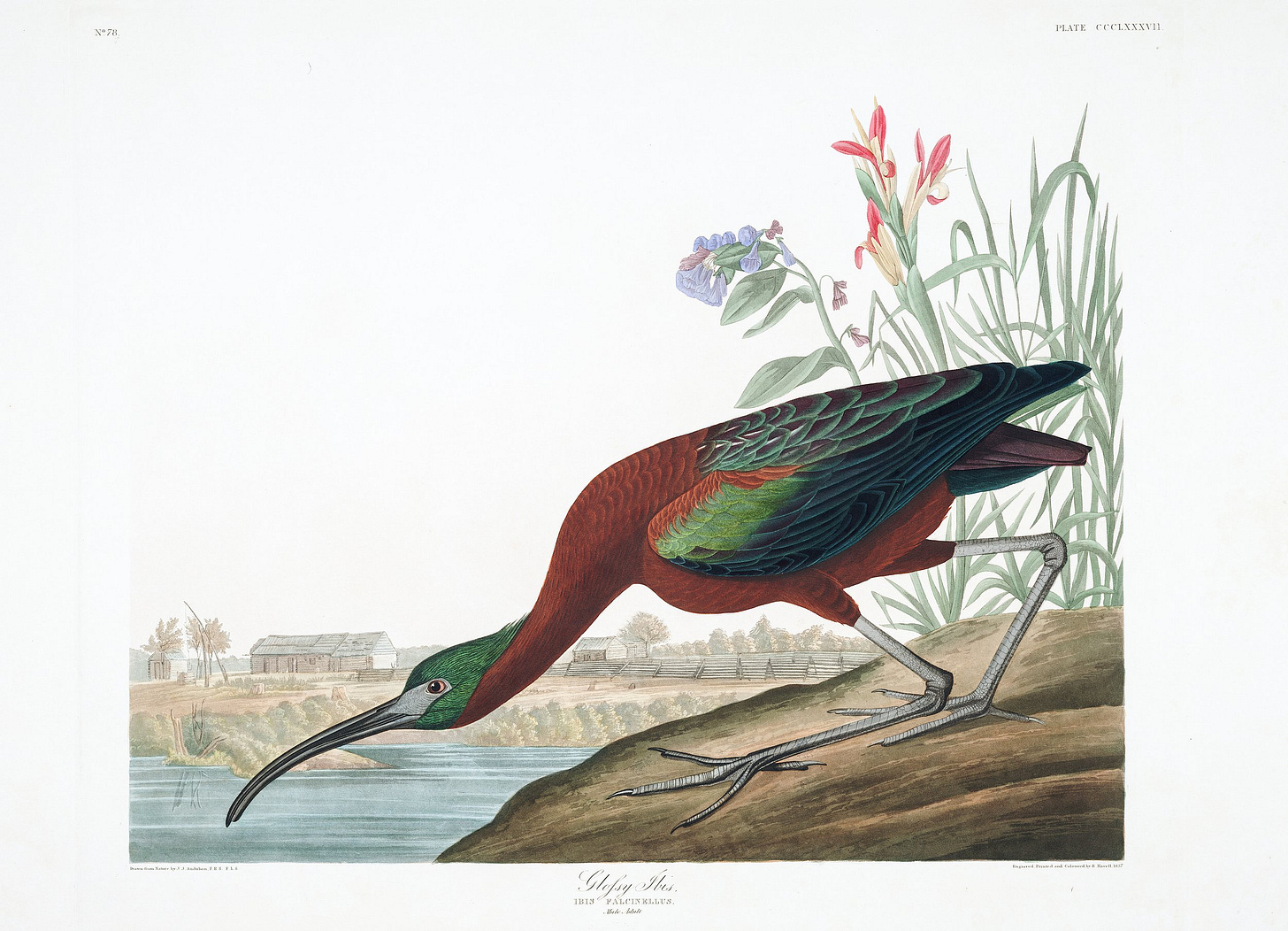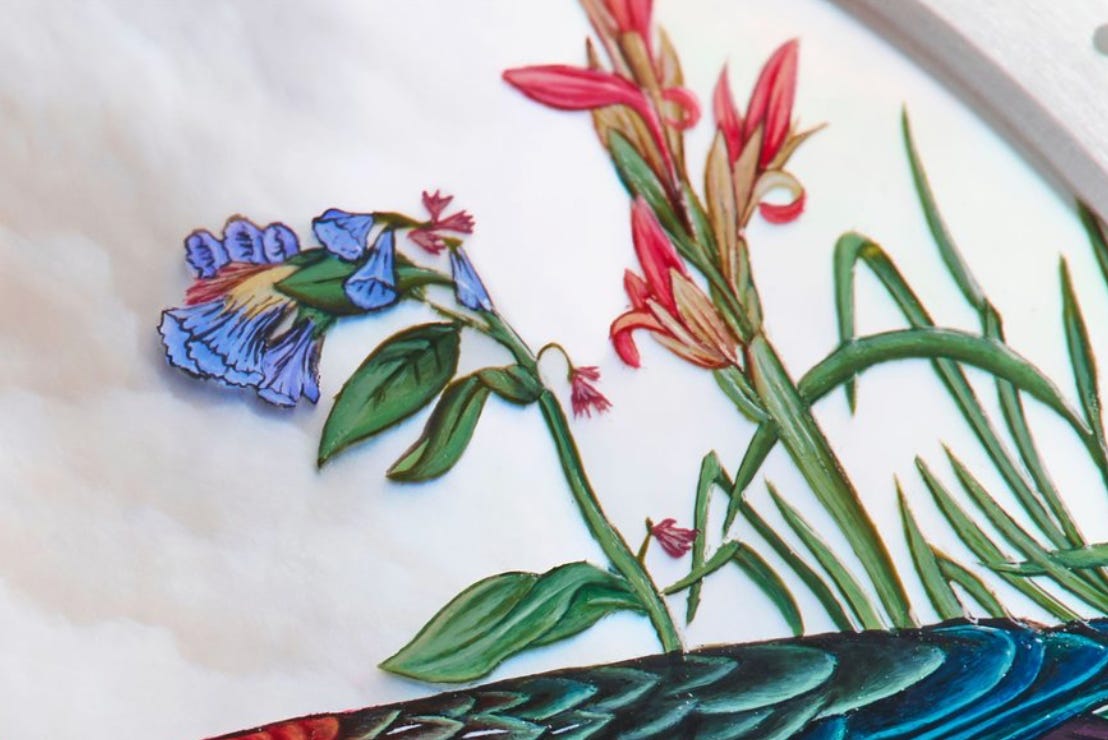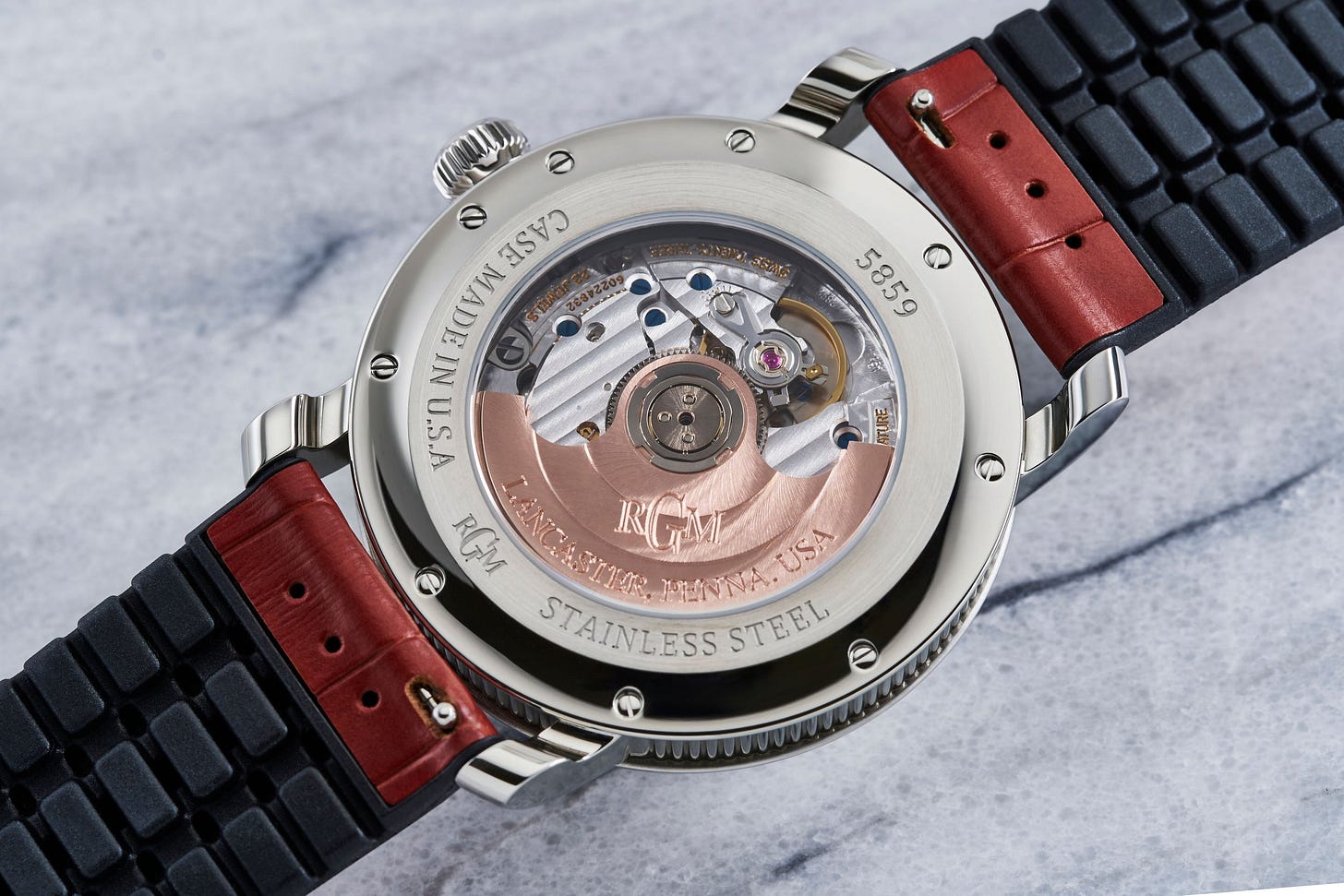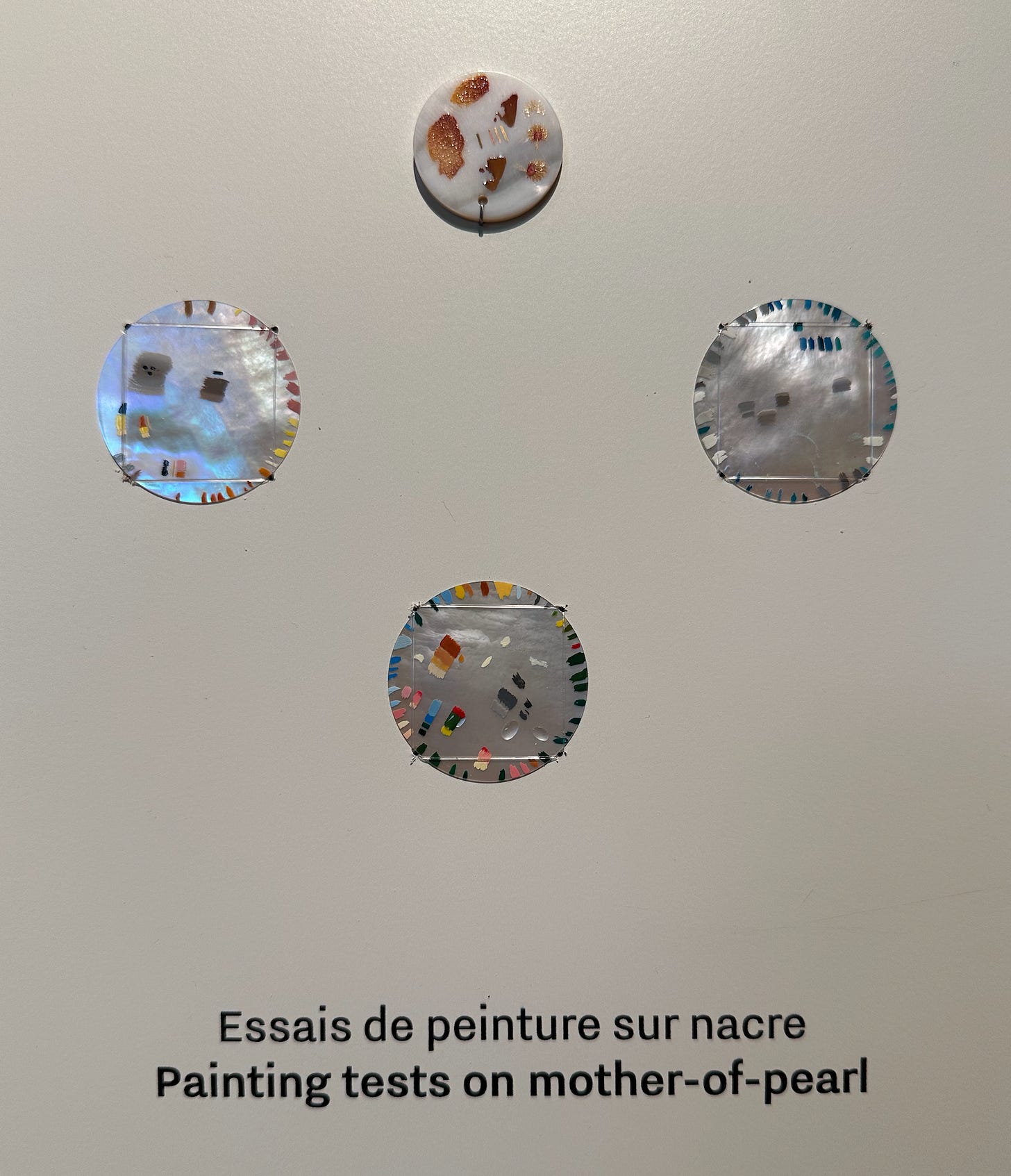Introducing: The RGM Model 25 “Birds of America” - Bespoke Miniature Painting on Mother-of-Pearl
Clients can choose from any illustration in John Audubon’s extensive collection of bird artwork to personalize their watch.
In June 2024, RGM, the premier American independent watch brand, introduced the first piece in its new Model 25 “Birds of America” series. Named “Glossy Ibis,” the dial of this watch features a miniature painting inspired by a drawing from the famed American naturalist and painter John Audubon.
RGM’s founder, Roland Murphy, has a deep love for wildlife photography, especially birds, which led him to choose from among Audubon's 435 original prints as inspiration for this collection. The best part? Potential clients can select any drawing from Audubon’s extensive collection to personalize their watch.
I’d long wanted to add a watch with a miniature painting to my collection, ideally showcasing a natural scene. Yet offerings from traditional brands are often beyond my price range, and despite their craftsmanship, I felt a lack of personal connection to the painted dials. This novel approach from RGM piqued my interest, and I eagerly dove in. Now, I have a watch with a dial personalized just for me to look forward to. Here’s the story I couldn’t wait to share with you.
A Brief Intro to RGM
Roland G. Murphy is a celebrated American watchmaker and the founder of RGM Watch Co., established in 1992 in Lancaster County, Pennsylvania. With expertise in both Swiss and American horology, Murphy created RGM to bring high-quality, handcrafted mechanical watches to the American market. His brand honors traditional watchmaking techniques, blending Swiss-style precision with distinctly American design and craftsmanship.
RGM stands out among American watch companies for producing timepieces with in-house movements, most notably the Caliber 801, a mechanical movement designed and built in the U.S. The brand is also known for its dedication to artistry, using vintage rose engine machines to craft intricate guilloché dials. Through RGM, Murphy has revived elements of American watchmaking heritage, positioning it as one of the few brands to celebrate and preserve traditional horological artistry in the United States.
RGM offers a wide range of watch styles, including classic dress watches with guilloché dials, pilot and field watches, chronographs, skeletonized models, and special editions inspired by American history and sports. One notable example is RGM’s baseball-themed watches with enamel dials.
The Model 25 series showcases artistically crafted dials, including cloisonné enamel, wood marquetry, guilloché, and miniature painting. These watches feature American-made cases inspired by RGM’s flagship Pennsylvania series, with a coin-edge ribbed side, a beautifully contoured bezel, a 40mm diameter, and elegantly curved lugs.
Model 25 “Birds of America” (Glossy Ibis)
Roland chose John Audubon’s exquisite artwork “Glossy Ibis” for the first piece in the “Birds of America” series. The Glossy Ibis is a medium-sized wading bird renowned for its iridescent plumage. Though its feathers may look dark from afar, close up they reveal metallic shades of green, purple, and bronze, especially in sunlight. Audubon’s illustration beautifully captures the Glossy Ibis, showcasing each feather’s intricate detail.
To create the dial art, Roland and his designer adapted Audubon’s original drawing into a circular design for the watch face. This artwork was then meticulously hand-painted by an artist onto a mother-of-pearl dial. The artist layered the paint step-by-step, with each layer dried in an oven heated to 90°C. This process was repeated approximately 20 times to achieve the final result.
On the reverse side, the movement is visible through the transparent caseback. RGM has modified the ETA 2892-A2 movement, enhancing the power reserve to 53-56 hours. The movement is fitted with an in-house gold winding rotor, decorated with perlage, côtes de Genève, and finished with rhodium plating, adding a refined touch to this exceptional timepiece.
The RGM Model 25 “Birds of America” watch is listed at $17,900.
Miniature Painter Isabelle Villa
For the “Birds of America” series, Roland has partnered with the talented French miniature painter Isabelle Villa. I hadn’t realized her esteemed reputation until I attended the Geneva Watch Days earlier this year.
From June 6 to September 2, 2024, the Fondation de la Haute Horlogerie (FHH) presented an exhibition in Geneva titled Watches and Talents, featuring Isabell Villa alongside other celebrated artisans such as Anita Porchet (enameller), Bastien Chevalier (marquetry inlayer), and Philippe Dufour (master watchmaker).
During the Geneva Watch Days, I had the chance to attend the exhibition and the conference Craftsmanship and the Human Value in Watchmaking on August 30. It was inspiring to learn about Villa’s work and reassuring to know that the “Birds of America” dials are truly in expert hands.
Choosing a John Audubon Illustration
John Audubon was a renowned 19th-century naturalist and artist famous for his detailed and lifelike illustrations of North American birds. Born in Haiti and raised in France, Audubon moved to the United States, where he dedicated himself to documenting the diversity of American bird species.
His most famous work, The Birds of America, features 435 hand-colored, life-size prints that vividly capture the appearance, behavior, and habitats of each species. Audubon’s artistic and scientific contributions made him a foundational figure in American natural history.
Honestly, it wasn’t easy to choose just one drawing from the 435 beautiful prints, with so many compelling options. It took me about a week or two, working on and off, to narrow it down to five candidates. I’ll show you four of them first, and then reveal the final choice.
My final choice is Plate #52, Chuck-will's-widow shown below. I love the lively scene of two birds with a snake, vividly portrayed by John Audubon.
To start, let’s hear from Audubon himself in the book about how this bird got its unique name.
“About the middle of March, the forests of Louisiana are heard to echo with the well-known notes of this interesting bird. No sooner has the sun disappeared, and the nocturnal insects emerged from their burrows, than the sounds, "chuck-will's-widow," repeated with great clearness and power six or seven times in as many seconds, strike the ear, brining to the mind a pleasure mingled with a certain degree of melancholy, which I have often found very soothing. The sounds of the Goatsucker, at all events, forbode a peaceful and calm night, and I have more than once thought, are conducive to lull the listener to repose.”
Next, we’ll look at why John Audubon chose to depict the birds alongside the snake — they were attempting to scare it away.
“The Chuck-will's-widow manifests a strong antipathy towards all snakes, however harmless they may be. Although these birds cannot in any way injure the snakes, they alight near them on all occasions, and try to frighten them away, by opening their prodigious mouth, and emitting a strong hissing murmur. It was after witnessing one of these occurrences, which took place at early twilight, that the idea of representing these birds in such an occupation struck me. The beautiful little snake, gliding along the dead branch, between two Chuck-will's-widows, a male and a female, is commonly called the Harlequin Snake, and is, I believe, quite harmless.”
Artwork for the Dial
After selecting the drawing, I sent my choice to Roland. A few days later, I received the first design, which looked great. I suggested some small adjustments, and Roland incorporated them, along with some additional ideas and options. Shortly after, we had the final artwork!
The design includes both birds and the snake, with intricate details in the birds' feathers, plants, and flowers. It forms a balanced circular composition with vibrant colors and a touch of open space around the edges to reveal the mother-of-pearl. I’m thrilled with how it turned out!
With the artwork finalized, Roland will send it to Isabelle Villa for miniature painting. Once the dial is complete, we’ll choose the hands and strap. The entire project is expected to take 7-8 months from the artwork's approval. I’m eagerly anticipating the finished watch — a unique American-themed timepiece with art on the dial. I’ll be sure to share it with you once it arrives.
Lastly, if you would like to hear the sound of Chuck-will’s widow, visit this page and click on the links to its songs.


